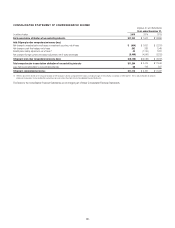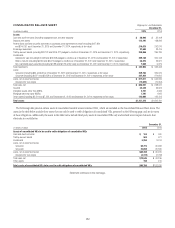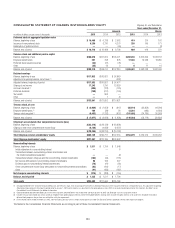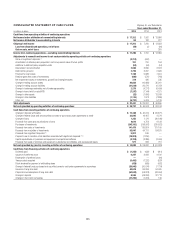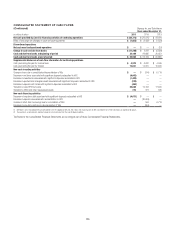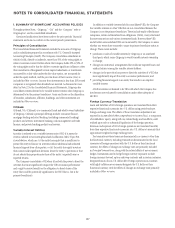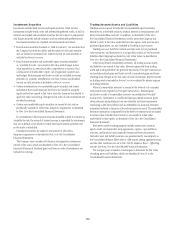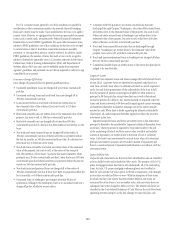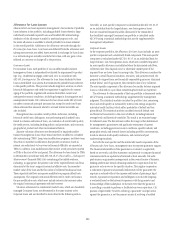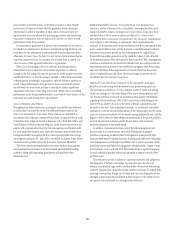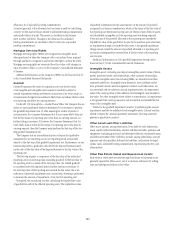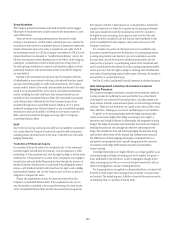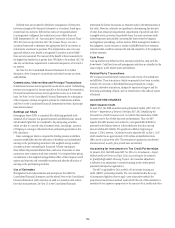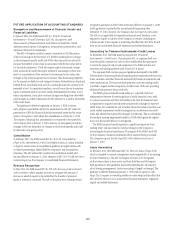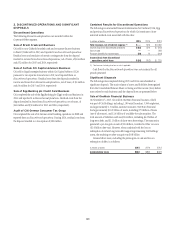Citibank 2015 Annual Report Download - page 159
Download and view the complete annual report
Please find page 159 of the 2015 Citibank annual report below. You can navigate through the pages in the report by either clicking on the pages listed below, or by using the keyword search tool below to find specific information within the annual report.141
Allowance for Loan Losses
Allowance for loan losses represents management’s best estimate of probable
losses inherent in the portfolio, including probable losses related to large
individually evaluated impaired loans and troubled debt restructurings.
Attribution of the allowance is made for analytical purposes only, and
the entire allowance is available to absorb probable loan losses inherent
in the overall portfolio. Additions to the allowance are made through the
Provision for loan losses. Loan losses are deducted from the allowance and
subsequent recoveries are added. Assets received in exchange for loan claims
in a restructuring are initially recorded at fair value, with any gain or loss
reflected as a recovery or charge-off to the provision.
Consumer Loans
For consumer loans, each portfolio of non-modified smaller-balance,
homogeneous loans is independently evaluated for impairment by product
type (e.g., residential mortgage, credit card, etc.) in accordance with
ASC 450, Contingencies. The allowance for loan losses attributed to these
loans is established via a process that estimates the probable losses inherent
in the specific portfolio. This process includes migration analysis, in which
historical delinquency and credit loss experience is applied to the current
aging of the portfolio, together with analyses that reflect current and
anticipated economic conditions, including changes in housing prices and
unemployment trends. Citi’s allowance for loan losses under ASC 450 only
considers contractual principal amounts due, except for credit card loans
where estimated loss amounts related to accrued interest receivable are
also included.
Management also considers overall portfolio indicators, including
historical credit losses, delinquent, non-performing and classified loans,
trends in volumes and terms of loans, an evaluation of overall credit quality,
the credit process, including lending policies and procedures, and economic,
geographical, product and other environmental factors.
Separate valuation allowances are determined for impaired smaller-
balance homogeneous loans whose terms have been modified in a troubled
debt restructuring (TDR). Long-term modification programs, and short-term
(less than 12 months) modifications that provide concessions (such as
interest rate reductions) to borrowers in financial difficulty, are reported as
TDRs. In addition, loan modifications that involve a trial period are reported
as TDRs at the start of the trial period. The allowance for loan losses for TDRs
is determined in accordance with ASC 310-10-35, Receivables—Subsequent
Measurement (formerly SFAS 114) considering all available evidence,
including, as appropriate, the present value of the expected future cash flows
discounted at the loan’s original contractual effective rate, the secondary
market value of the loan and the fair value of collateral less disposal costs.
These expected cash flows incorporate modification program default rate
assumptions. The original contractual effective rate for credit card loans is
the pre-modification rate, which may include interest rate increases under
the original contractual agreement with the borrower.
Valuation allowances for commercial market loans, which are classifiably
managed Consumer loans, are determined in the same manner as for
Corporate loans and are described in more detail in the following section.
Generally, an asset-specific component is calculated under ASC 310-10-35
on an individual basis for larger-balance, non-homogeneous loans
that are considered impaired and the allowance for the remainder of
the classifiably managed Consumer loan portfolio is calculated under
ASC 450 using a statistical methodology that may be supplemented by
management adjustment.
Corporate Loans
In the corporate portfolios, the Allowance for loan losses includes an asset-
specific component and a statistically based component. The asset-specific
component is calculated under ASC 310-10-35, on an individual basis for
larger-balance, non-homogeneous loans, which are considered impaired.
An asset-specific allowance is established when the discounted cash flows,
collateral value (less disposal costs) or observable market price of the
impaired loan are lower than its carrying value. This allowance considers the
borrower’s overall financial condition, resources, and payment record, the
prospects for support from any financially responsible guarantors (discussed
further below) and, if appropriate, the realizable value of any collateral.
The asset-specific component of the allowance for smaller balance impaired
loans is calculated on a pool basis considering historical loss experience.
The allowance for the remainder of the loan portfolio is determined under
ASC 450 using a statistical methodology, supplemented by management
judgment. The statistical analysis considers the portfolio’s size, remaining
tenor and credit quality as measured by internal risk ratings assigned to
individual credit facilities, which reflect probability of default and loss
given default. The statistical analysis considers historical default rates
and historical loss severity in the event of default, including historical
average levels and historical variability. The result is an estimated range
for inherent losses. The best estimate within the range is then determined
by management’s quantitative and qualitative assessment of current
conditions, including general economic conditions, specific industry and
geographic trends, and internal factors including portfolio concentrations,
trends in internal credit quality indicators, and current and past
underwriting standards.
For both the asset-specific and the statistically based components of the
Allowance for loan losses, management may incorporate guarantor support.
The financial wherewithal of the guarantor is evaluated, as applicable,
based on net worth, cash flow statements and personal or company financial
statements which are updated and reviewed at least annually. Citi seeks
performance on guarantee arrangements in the normal course of business.
Seeking performance entails obtaining satisfactory cooperation from the
guarantor or borrower in the specific situation. This regular cooperation
is indicative of pursuit and successful enforcement of the guarantee; the
exposure is reduced without the expense and burden of pursuing a legal
remedy. A guarantor’s reputation and willingness to work with Citigroup
is evaluated based on the historical experience with the guarantor and
the knowledge of the marketplace. In the rare event that the guarantor
is unwilling or unable to perform or facilitate borrower cooperation, Citi
pursues a legal remedy; however, enforcing a guarantee via legal action
against the guarantor is not the primary means of resolving a troubled


